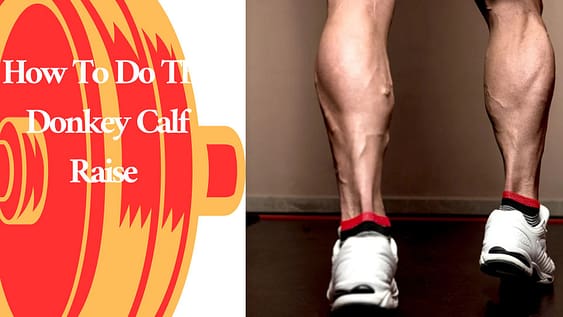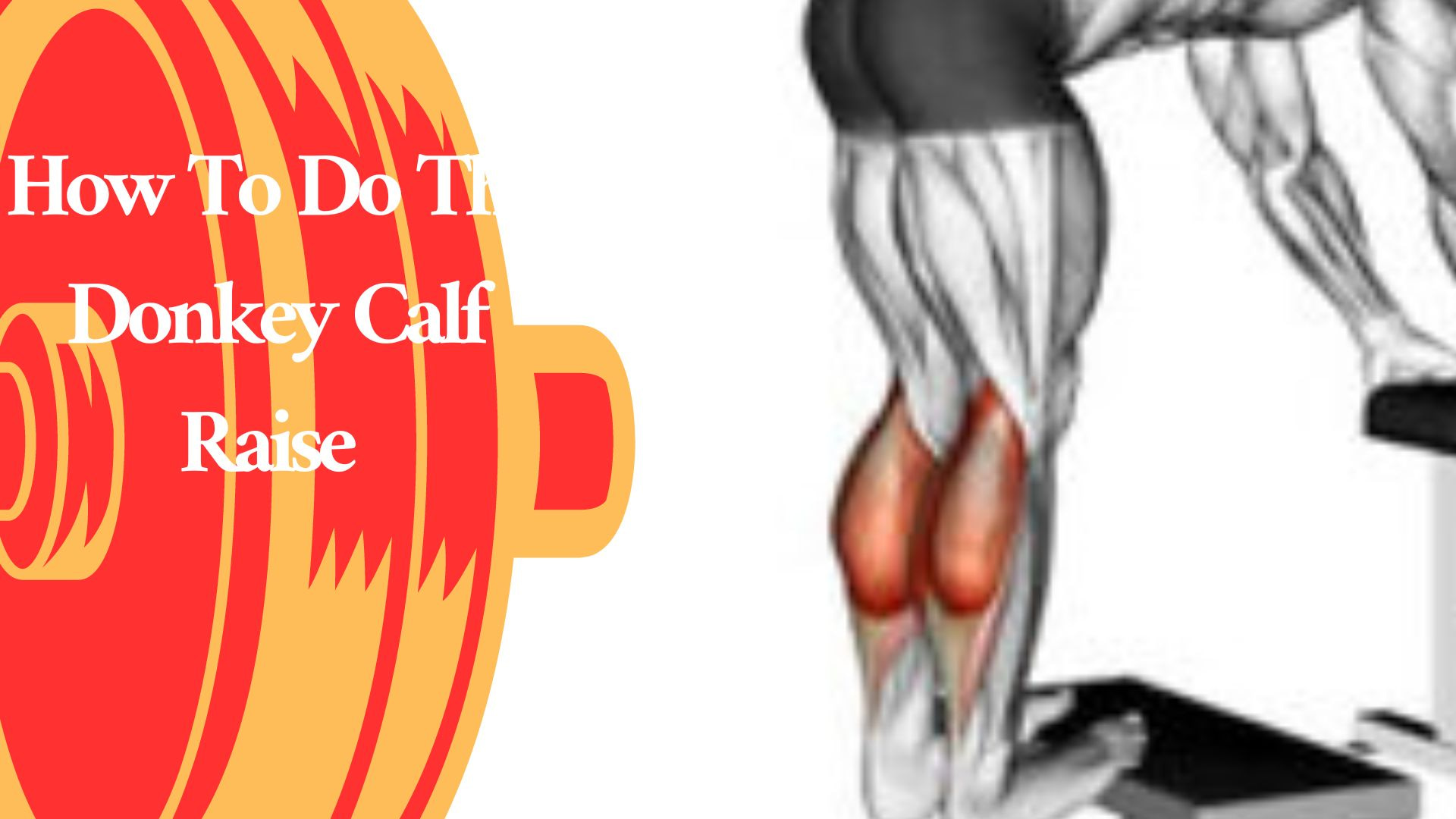It helps strengthen these crucial muscles, which are critical for maintaining balance, posture, and control during dynamic exercises like running and jumping.
Regular exercise can also help prevent injuries related to weak calf muscles, such as shin splints. Place your feet shoulder-width apart on a raised platform or bench with your toes pointed forward. 7
Then lean forward slightly, so your arms rest comfortably across the back of a stability ball or weight plate between your feet.
What Are Donkey Calf Raises?
Donkey calf raises are a popular exercise for strengthening the calf muscles of the lower leg. They can be performed using either a machine or by doing them with body weight and are often used in strength training programs to improve balance, posture, and coordination.
The exercise involves standing behind an elevated platform roughly the same height as your knees. You then place your toes on the platform and lean forward while keeping your back straight.
From here, you lift onto your toes while keeping your heels off the ground and hold this position before slowly lowering yourself back down to the starting position. To increase difficulty, you can add weight to challenge yourself further.
Donkey calf raises are an effective way to strengthen your calves and build explosive power in these muscles, essential for any athlete who wants to reach peak performance levels.
List Of Steps To Do The Donkey Calf Raise For Soleus And Gastrocnemius Muscles
- Stand in front of a sturdy object such as a bench and adjust it to waist height
- take a couple of steps backward and place your feet on an aerobic step or two larger weight plates.
- Rotate your shoulders outward to engage your lats.
- Hinge your hips backward until your back is parallel to the floor
- Maintaining your alignment, push the balls of your feet into the aerobic steps
- Slowly lower back to the starting position
-
Stand before a sturdy object, such as a bench, and adjust it to waist height.
To begin the exercise, stand on the edge of the bench with your feet shoulder-width apart and your toes facing forward. With your hands supporting yourself on either side of the court, lower your heels toward the ground. Hold this position for one second before pushing onto your toes and raising yourself as high as possible off the bench.
-
Take a few steps backward and place your feet on an aerobic step or two larger weight plates.
When it comes to achieving a firm, toned lower body, the Donkey Calf Raise is one of the best exercises. This exercise targets the soleus and gastrocnemius muscles in your calves, which helps with stability and strength.

It would be best to start by standing with both feet flat on the steps and slowly lifting yourself onto your toes while keeping your back straight.
Then, slowly lower yourself until you feel the soleus or gastrocnemius muscle tension. You can also add variations to this workout, such as transferring weight from one foot to another for more intensity or using weighted objects for added resistance.
-
Rotate your shoulders outward to engage your lats.
Rotating your shoulders outward is critical in performing the donkey calf raise for Soleus and Gastrocnemius.
This exercise helps to engage your lats, or latissimus dorsi, which are two large muscles on either side of the back used for specific movements.
Doing this exercise can help you to gain strength and enhance performance when doing other leg exercises, such as squats and deadlifts.
To begin, stand with your feet shoulder-width apart with a slight bend in your knees and rotate your shoulders outward, slightly away from the body’s midline.
With one hand grasping a stable surface like a wall or pole above hip height, contract the abdominal muscles as you pull them up towards the sky.
-
Hinge your hips backward until your back is parallel to the floor.
When hinging your hips backward, keep your feet flat and your toes pointing forward. Keep your legs straight and maintain a slight knee bend throughout the movement.
Your arms should be placed comfortably on either side of your body with palms facing down towards the ground. As you hinge your hips back, draw in your abdominal muscles and squeeze your buttocks together for additional stability.
-
Maintaining your alignment, push the balls of your feet into the aerobic steps.
Maintaining your alignment and pushing the balls of your feet into the aerobic is an essential part of continuing with a Donkey Calf Raise for Soleus and Gastrocnemius.
This critical exercise helps to strengthen both muscles in the lower leg, making them more resistant to fatigue during activities such as running or jumping. The donkey calf raise helps to increase muscular endurance, promote balance, and build muscle mass in the calves.
Maintaining proper form when performing this exercise is essential to ensure maximum benefits while avoiding any potential injuries resulting from improper technique.
When you begin this exercise, ensure your back is straight and your feet are firmly planted on the floor with your toes pointing slightly outward. Push through the balls of your feet into the aerobic platform before slowly lowering yourself down until you feel a stretch in the calf muscles before returning slowly back up again.
-
Slowly lower back to the starting position.
Lowering your body back to the starting position in a slow and controlled manner allows you to get the most out of each repetition of this exercise.
Slowly reduce yourself back down; you can better focus on contracting these muscles as you move through each repetition.
It also helps engage other stabilizing muscles to maintain good form throughout the movement so you can do it safely and efficiently.
Additionally, slowing down as you move will ensure that tension remains on the targeted muscles, making them work harder and thus resulting in more significant gains over time.
Equipment Needed
This exercise can be performed even without any weight or machine. In that case, you are using your body weight to train your calf. Using a donkey calf raise machine or caring for one of your training partners, an old school way to train calf.
Carrying your training partner is one of the oldest system used to train calf before the insistence of the donkey calf raise machine or any other type of calf training machine. Set the donkey calf raise machine to your size before beginning the exercise.
Precaution
Here are the precautions and safety steps during the donkey calf raise. Follow them for perfect performance whenever you want to do this exercise.
- Position yourself very well. Focus and be still. Keep a correct position throughout the performance. Your feet should be less than your shoulder width.
- Hook your lower back under the donkey calf machine pad tight. The pad must be resting on the lower part of your back don’t rest on your heels, and do not create any difficulty.
- Make sure that you keep your knees motionless throughout the entire exercise. Adjust the machine according to your size.
- Keep the calf working and concentrate. Keep only your calf working slow and steady and concentrated.
- Extend only your ankles do not extend or bend your legs when you lift your heel. Make sure that you don’t move your knees. Flex harder at the top before slowly lowering the weight back to the starting position.
- The down motion should be slightly slower than the up motion, though.
Benefits
Here are some benefit of doing the donkey calf raise
- An effective exercise to train and strengthen the calf, the donkey calf raise is an effective exercise in training calf better than any other exercise.
- It boosts strength to the lower body and helps to develop the soleus muscle to the lower calf.
- It is also an effective gastrocnemius exercise that helps with the development of mass and power to the calf.
- It shapes up your lower body and helps increase muscle tissue. The donkey calf raise helps add a V-shape to your leg and trains the lower leg muscle.
Final Thoughts
In conclusion, the donkey calf raise is an excellent way to target the soleus and gastrocnemius muscles. It’s important to remember that proper form is essential to reap this exercise’s full benefits.
Begin with a lighter weight, take it slowly and ensure you feel the muscle working before adding more weight. Keep your core engaged while doing this exercise to help stabilize the body and protect against injuries.


